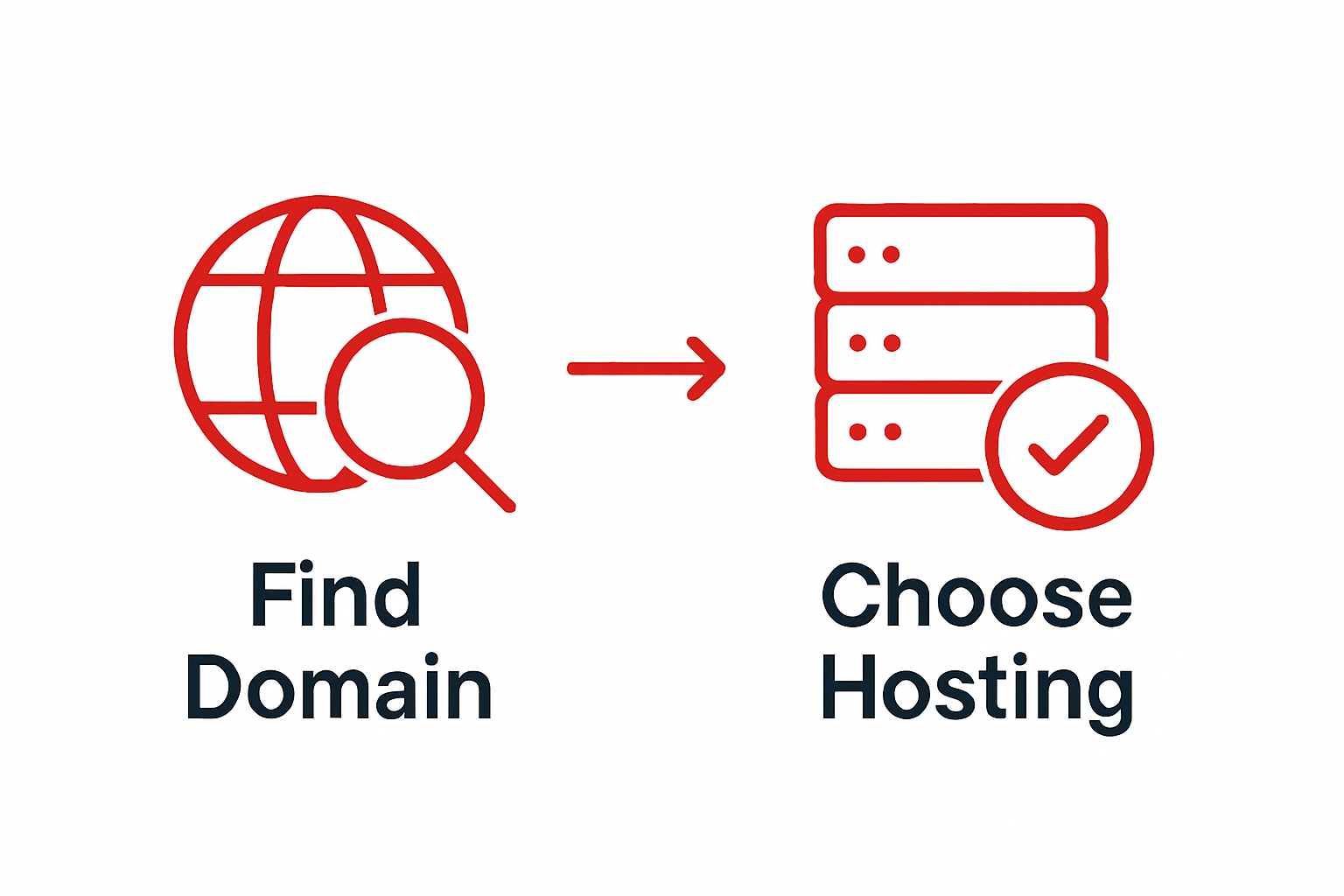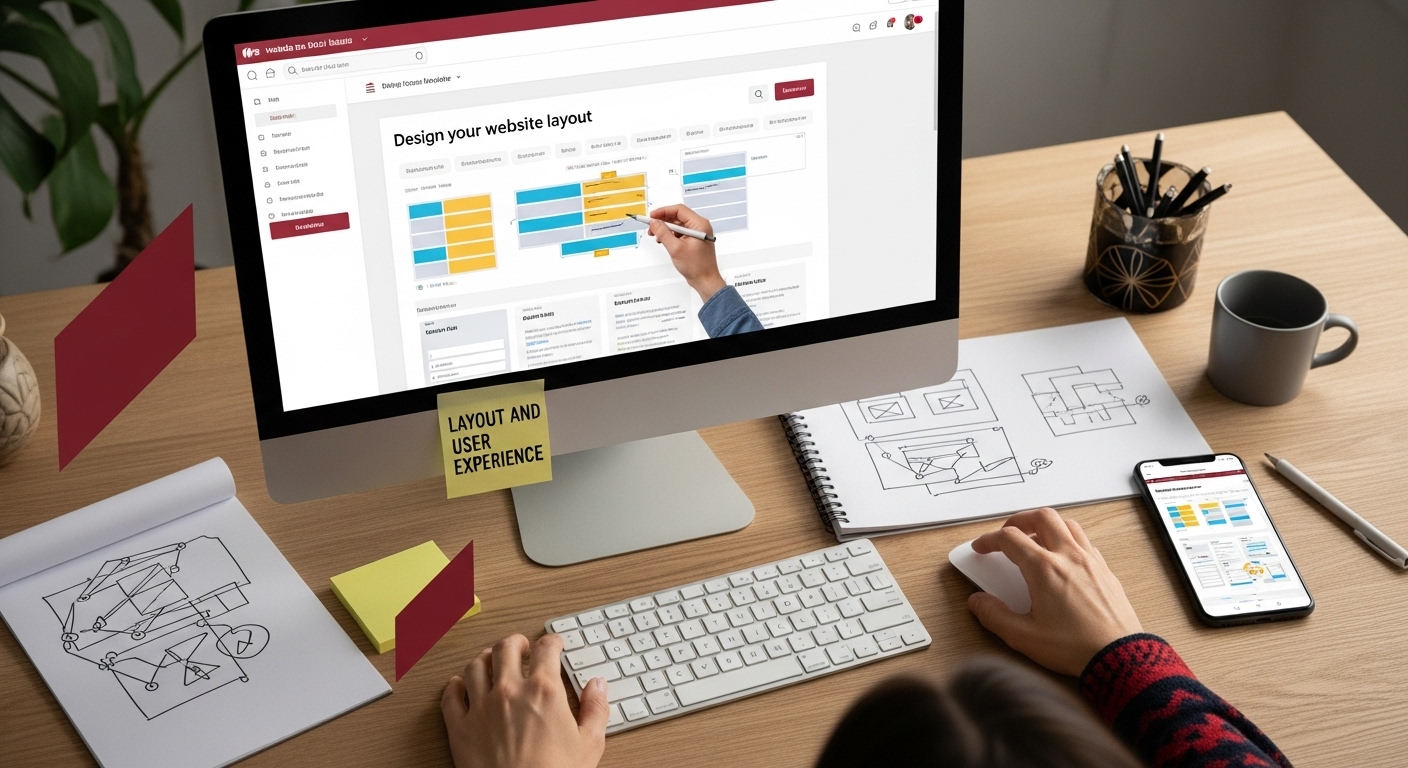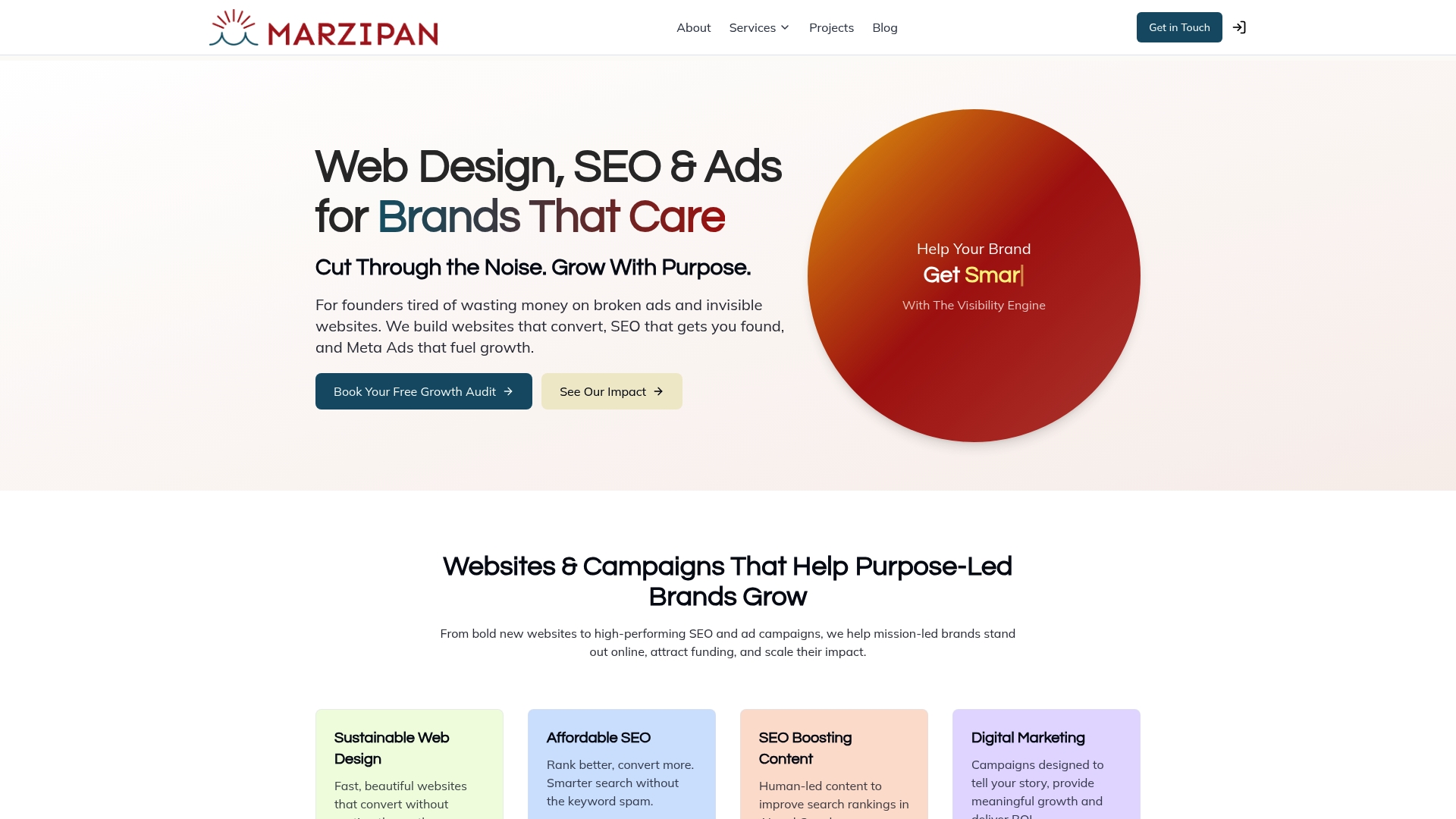How to Design a Website: A Step-by-step Guide
Building a website from scratch can feel overwhelming when every decision shapes your brand’s digital future. Over 40 percent of all websites are powered by just one platform, which might seem surprising at first. The real secret is that the strongest websites succeed not because of fancy tech, but because they start with a clear purpose and smart planning—something anyone can achieve with the right guidance.
Table of Contents
- Step 1: Define Your Website’s Purpose And Goals
- Step 2: Choose A Domain Name And Hosting Service
- Step 3: Select A Website Builder Or Content Management System
- Step 4: Design Your Website Layout And User Experience
- Step 5: Create And Optimise Your Website Content
- Step 6: Test Your Website And Launch It
Quick Summary
| Key Point | Explanation |
|---|---|
| 1. Define clear website goals | Establish measurable objectives to guide website design and content decisions, ensuring alignment with your target audience’s needs. |
| 2. Choose a memorable domain name | Select a domain that reflects your brand identity, is easy to remember, and aids in local SEO for better discoverability. |
| 3. Select an appropriate CMS | Choose a website builder or CMS that matches your technical skills and requirements, facilitating ease of use and management. |
| 4. Design for usability and responsiveness | Create an intuitive layout that enhances user experience across devices, ensuring smooth navigation and readability. |
| 5. Test thoroughly before launch | Conduct comprehensive testing to ensure functionality, performance, accessibility, and security, promoting a reliable user experience. |
Step 1: Define your website’s purpose and goals
Before diving into design elements and colour palettes, understanding your website’s fundamental purpose is crucial. Every successful website begins with crystal clear objectives that guide its entire development strategy. Your website’s purpose acts as a strategic compass, directing every design decision and content choice you will make.
Starting with comprehensive goal setting helps you create a focused digital platform that speaks directly to your target audience. Consider what primary outcome you want to achieve. Are you aiming to sell products, share information, generate leads, or build a community platform? Your specific goals will determine the entire structure and functionality of your website.
To effectively define your website’s purpose, start by conducting a thorough assessment of your business or personal objectives. This involves examining your target audience, understanding their needs, and identifying how your website can provide value. Break down your goals into specific, measurable categories such as increasing brand awareness, driving online sales, providing customer support, or establishing thought leadership in your industry.
Recommend creating a concise goal statement that articulates your website’s primary mission. This statement should be precise and actionable, outlining exactly what you want to accomplish. For instance, “Our website will provide sustainable web design resources for mission-led businesses in Sydney, offering actionable insights and professional guidance” provides a clear, focused direction.
Remember that your website’s purpose might evolve, so design flexibility into your initial strategy. Our comprehensive guide on sustainable web design can help you create a dynamic digital platform that adapts to changing business needs while maintaining a strong core objective.
Verification of successful goal setting includes having a written document that clearly outlines:
- Specific website objectives
- Target audience description
- Key performance indicators (KPIs)
- Anticipated user actions and interactions
By meticulously defining your website’s purpose and goals, you establish a solid foundation for a strategic, effective digital presence that genuinely connects with your intended audience.
Step 2: Choose a domain name and hosting service
Selecting the right domain name and hosting service represents a critical foundation for your website’s online presence. This step transforms your digital vision from a concept into a tangible online platform that audiences can discover and interact with.
Your domain name serves as your website’s digital address, functioning like a virtual storefront sign that communicates your brand’s identity and purpose. When brainstorming potential domain names, prioritise options that are memorable, concise, and directly reflect your website’s core mission. Aim for names that are easy to spell, pronounce, and type. Avoid complex spellings, hyphens, or unnecessarily long combinations that might confuse potential visitors.
Consider registering a domain name that includes keywords related to your business or service. For Australian businesses, country-specific domains like .com.au can provide additional local credibility and help with regional search engine optimization. Conduct thorough research to ensure your preferred domain name is not already registered and check its availability across multiple domain registrars.
Parallel to selecting a domain name, choosing an appropriate web hosting service is equally crucial. Web hosting determines your website’s performance, reliability, and accessibility. Different hosting options include shared hosting, virtual private servers (VPS), dedicated hosting, and cloud hosting.
Below is a comparison of common website hosting options to help you select the best choice for your needs.
| Hosting Type | Resources & Control | Typical Use Case | Scalability |
|---|---|---|---|
| Shared Hosting | Limited, low control | Small/start-up websites | Low |
| VPS (Virtual Private Server) | Moderate resources, more control | Medium business/traffic sites | Moderate |
| Dedicated Hosting | High resources, full control | High-traffic or complex sites | High |
| Cloud Hosting | Flexible, scalable resources | Growing or fluctuating sites | Very High |
Each option offers varying levels of resources, control, and pricing structures.
When evaluating hosting providers, consider critical factors such as:
- Uptime guarantees
- Server performance and speed
- Customer support quality
- Scalability options
- Security features
- Pricing structures
Learn more about sustainable web hosting solutions that align with mission-driven businesses and environmental considerations. According to auDA’s official domain registration guidelines, Australian businesses should carefully review domain eligibility criteria and choose accredited registrars.
Verification of successful domain and hosting selection includes confirming you have:
- A registered domain name matching your brand
- A hosting plan that meets your website’s technical requirements
- Access credentials for domain and hosting management
- Completed initial setup and DNS configuration
By meticulously selecting your domain name and hosting service, you establish a robust digital foundation that supports your website’s long-term growth and success.

Step 3: Select a website builder or content management system
Choosing the right website builder or content management system (CMS) represents a pivotal moment in your website creation journey. This decision will significantly impact your website’s functionality, design flexibility, and long-term management capabilities. Think of your CMS as the digital engine that powers your entire online presence, determining how easily you can create, modify, and maintain your website content.
For mission-driven businesses seeking a streamlined approach, user-friendly website builders offer an accessible entry point. These platforms provide drag-and-drop interfaces, pre-designed templates, and integrated hosting solutions that simplify the website development process. Popular options like WordPress, Wix, and Squarespace cater to different skill levels and design requirements, allowing you to create professional-looking websites without extensive technical knowledge.
More advanced users might prefer robust content management systems that offer greater customization and control. WordPress remains the most widely used CMS globally, powering over 40% of all websites. Its extensive plugin ecosystem and flexible design options make it particularly attractive for businesses wanting to scale and adapt their digital platforms. Other powerful CMS alternatives include Drupal and Joomla, which provide advanced features for complex website architectures.
When evaluating website builders and CMS platforms, consider critical factors that align with your specific goals. Assess aspects such as:
- Ease of use and learning curve
- Customization capabilities
- Mobile responsiveness
- SEO integration
- E-commerce functionality
- Security features
- Cost and ongoing maintenance requirements
Explore sustainable web design solutions that complement your chosen platform and support mission-driven digital strategies. According to Business Victoria’s website development guidelines, researching website building platforms is a crucial step in creating a successful online presence.
Verification of successful CMS selection includes confirming you have:
- Thoroughly tested your chosen platform
- Understood its core functionalities
- Confirmed compatibility with your website objectives
- Developed a basic content strategy
By carefully selecting a website builder or CMS that matches your technical skills and business requirements, you establish a solid technological foundation for your digital platform.
Step 4: Design your website layout and user experience
Designing your website layout and user experience transforms your digital platform from a mere collection of pages into an engaging, intuitive journey for your visitors. This crucial step determines how effectively your website communicates its purpose and guides users through their interaction with your digital space.
Visual hierarchy plays a fundamental role in creating an exceptional user experience. Strategically arrange content elements to draw users’ attention to the most important information. Consider the natural reading patterns of your target audience, typically following an F-shaped or Z-shaped scanning pattern. Place critical messages, calls to action, and key information where users are most likely to notice them.
Mobile responsiveness is no longer optional but essential. With over 60% of web traffic now originating from mobile devices, your website must function seamlessly across smartphones, tablets, and desktop computers. This means designing flexible layouts that adapt gracefully to different screen sizes, ensuring text remains readable, buttons are easily tappable, and navigation remains intuitive regardless of the device used.
Color psychology and typography significantly impact user perception and engagement. Select a color palette that reflects your brand’s personality and evokes the right emotional response from your audience. Choose fonts that are not only visually appealing but also highly legible across different devices. Maintain consistency in your design elements to create a cohesive and professional appearance.
Navigation should be simple and intuitive. Users should be able to find what they’re looking for within three clicks. Create clear, descriptive menu labels and implement a logical site structure that guides visitors effortlessly through your content. Consider using breadcrumb navigation for more complex websites to help users understand their current location within your site’s hierarchy.
Explore our sustainable web design principles to create a user-centric digital experience. According to the Australian Government’s Digital Transformation Agency, conducting thorough user research is critical in designing services that truly meet user needs.
Verification of successful website layout design includes:
- Consistent and appealing visual design
- Responsive performance across multiple devices
- Clear and intuitive navigation
- Readable typography and balanced color scheme
- Smooth user flow between different sections
By meticulously crafting your website’s layout and user experience, you create a digital platform that not only looks professional but also provides genuine value to your visitors.

Step 5: Create and optimise your website content
Content creation represents the heart and soul of your website, transforming your digital platform from a mere visual experience into a meaningful communication channel. Compelling content bridges the gap between your website’s design and its ability to engage, inform, and convert visitors.
Start by developing a comprehensive content strategy that aligns with your website’s core objectives. This involves crafting clear, concise, and valuable content that speaks directly to your target audience. Focus on creating materials that answer your visitors’ most pressing questions, address their pain points, and provide genuine value. Use a conversational tone that feels authentic and approachable, avoiding industry jargon that might alienate readers.
Search engine optimization plays a critical role in content creation. Strategically incorporate relevant keywords throughout your content, ensuring they appear naturally within headings, paragraphs, and metadata. However, prioritize readability and user experience over keyword density. Modern search algorithms reward content that genuinely helps users, so concentrate on creating informative, well-structured pieces that provide real insights.
Visual elements are equally important in content optimization. Break up text with high-quality images, infographics, and videos that complement your written content. These visual assets not only make your content more engaging but also help explain complex concepts more effectively. Ensure all visual elements are properly optimized for web performance, with compressed file sizes and descriptive alt text for accessibility.
Explore our expert content creation services to elevate your website’s communication strategy. According to the Australian Government’s Style Manual, effective content requires careful planning and a user-centric approach.
Verification of successful content creation includes:
- Clear, purpose-driven messaging
- Consistent brand voice and tone
- Properly optimized text and visual elements
- Engaging and informative material
- Alignment with website objectives
By meticulously crafting and optimizing your website content, you create a powerful digital narrative that connects meaningfully with your audience and supports your overall business goals.
Step 6: Test your website and launch it
Website testing represents the final critical checkpoint before introducing your digital platform to the world. This comprehensive evaluation ensures your website functions flawlessly, delivers an exceptional user experience, and meets all technical and aesthetic standards you’ve established throughout the development process.
Comprehensive testing involves a multi-faceted approach that examines every aspect of your website’s performance. Begin by conducting thorough cross-browser compatibility checks, verifying that your website renders correctly and functions seamlessly across different browsers like Chrome, Firefox, Safari, and Edge. Pay special attention to responsive design elements, ensuring that your layout adapts perfectly to various screen sizes and devices, from desktop computers to smartphones and tablets.
Performance testing is equally crucial. Utilize tools that measure website loading speed, assessing how quickly your pages load under different network conditions. Slow-loading websites can dramatically increase bounce rates, so aim to keep your loading times under three seconds. Compress images, minimize code, and leverage browser caching to optimise your website’s speed and responsiveness.
Accessibility testing ensures your website is usable for all individuals, including those with disabilities. Check that your site meets Web Content Accessibility Guidelines (WCAG), which includes providing alternative text for images, ensuring keyboard navigation, and maintaining sufficient color contrast. This not only improves user experience but also demonstrates your commitment to inclusivity.
Security represents another critical testing dimension. Verify that all forms are secure, sensitive information is properly encrypted, and potential vulnerabilities are addressed. Implement SSL certificates, conduct basic security scans, and ensure your website is protected against common digital threats.
Explore our comprehensive website testing services to ensure a smooth digital launch. According to the Northern Territory Government’s Website Testing Guideline, systematic testing is essential for delivering a high-quality digital experience.
Verification of successful website testing includes:
- Consistent performance across multiple browsers and devices
- Fast loading times
- Full accessibility compliance
- Robust security measures
- Smooth user navigation and interaction
By meticulously testing your website before launch, you establish a solid foundation for a professional, reliable, and user-friendly digital platform.
Use the following checklist to verify that your website is ready for launch, covering key performance, accessibility, and security aspects.
| Launch Checklist Item | Description | Verification |
|---|---|---|
| Cross-browser performance | Works seamlessly on Chrome, Firefox, Safari, Edge | Yes/No |
| Responsive on all devices | Layout adapts to desktop, mobile, and tablets | Yes/No |
| Loading speed optimised | Pages load within three seconds | Yes/No |
| Accessibility compliance | Meets WCAG standards; usable by all users | Yes/No |
| Security features in place | SSL certificate and protection against threats | Yes/No |
| Clear navigation and user flow | Smooth, intuitive user experience throughout | Yes/No |
Ready to Launch a Purpose-Driven Website with Real Impact?
Building a website that truly reflects your mission and connects with your audience can be overwhelming. You want a platform that’s clear in its purpose, easy to use across every device and genuinely optimised to grow your business. Yet, between selecting the right domain, designing the perfect layout and ensuring annoying technical hiccups do not stand in your way, it is easy to feel lost or stuck. The steps in our guide, from goal setting to content optimisation, reveal how much thoughtful planning it takes to succeed online. But you do not have to face this journey alone.

If you are ready for a website that goes beyond the basics—one that brings your vision to life in a way that is sustainable and supports your long-term goals—partner with us at Marzipan. Our experience in sustainable web design and expert content creation services covers everything you have just read about. Let us help you skip the frustration and launch with confidence. Book a free consultation today and see how your next website can become your strongest digital asset. Act now to ensure your next step truly moves your business forward.
Frequently Asked Questions
What are the first steps to designing a website?
Understanding your website’s purpose and goals is crucial. Conduct a thorough assessment of your business objectives and target audience to create a focused digital platform.
How do I choose the right domain name for my website?
Select a domain name that is memorable, concise, and reflects your website’s mission. Consider including keywords related to your business and ensure the name is easy to spell and type.
What should I consider when selecting a website builder or content management system?
Evaluate factors such as ease of use, customization capabilities, mobile responsiveness, SEO integration, and cost when choosing a website builder or CMS that aligns with your specific goals.
How can I optimise my website content for search engines?
Incorporate relevant keywords naturally throughout your content, maintain readability, and ensure your visuals are optimised for web performance. Focusing on creating informative and engaging material is key to SEO success.







